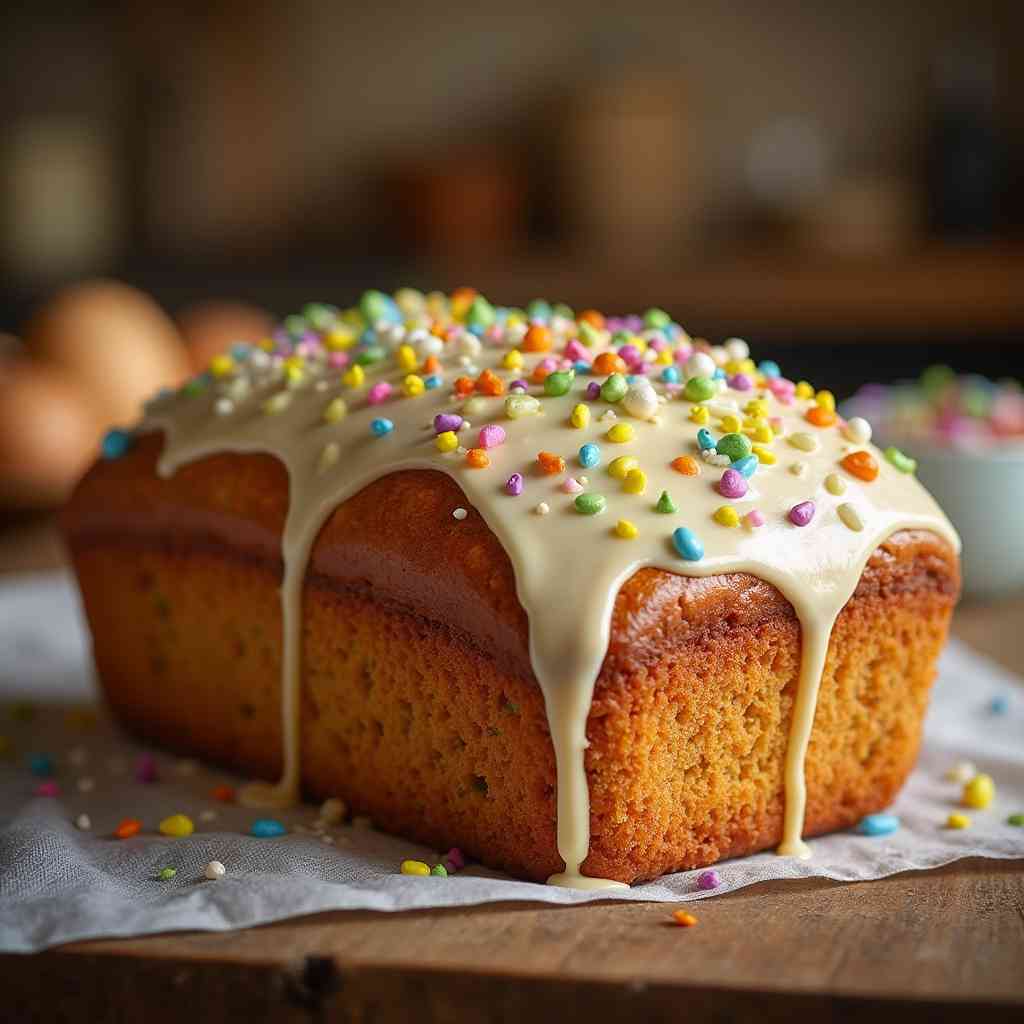Mennonite Paska Recipe is a soft, sweet Easter bread flavored with lemon and orange zest, traditionally baked by Mennonite families to celebrate spring and renewal. It’s known for its light, fluffy texture and is often topped with a vanilla glaze and festive sprinkles.
This beloved recipe is easy to make at home using simple ingredients like flour, eggs, milk, and citrus. Whether served at brunch or given as a gift, Mennonite paska is a delicious way to honor tradition and bring people together. In this post, you’ll learn exactly how to make authentic Mennonite Paska from scratch step by step./table
Table of Contents
What Is Mennonite Paska?
Ever wonder why this Easter bread is called “paska”? Well, why not sprinkle in a bit of humor like “Did the loaf take a pledge of pious simplicity?” Traditionally, “paska” (derived from the Russian and Ukrainian word for Easter) symbolizes renewal and community.

Picture a scene where the whole Mennonite village gathers, and someone exclaims, “The way to a man’s heart is through his stomach,” as they pass around warm slices. This lighthearted saying captures the essence of why paska is so beloved: it’s more than bread; it’s a gesture of love. So, are you curious to taste what all the fuss is about? Don your apron and let’s try this mennonite paska recipe together your friends and family will thank you!
Why You’ll Love This Mennonite Paska Recipe
- Soft, Citrus-Scented Perfection
The star of this bread is its tender, fluffy texture, complemented by bright notes of lemon and orange zest. Each bite melts in your mouth, leaving a hint of sweetness that’s neither cloying nor overpowering. - Cost-Saving, Home-Baked Goodness
Making paska at home is surprisingly budget-friendly. Instead of purchasing artisan Easter breads at high prices, combine pantry staples flour, sugar, eggs, citrus zest, and save money without sacrificing flavor. Plus, the satisfaction of kneading and watching the dough rise is priceless. - Endless Toppings & Variations
From classic vanilla glaze to a simple dusting of powdered sugar, there’s room to experiment. Try drizzling homemade lemon icing or topping with pastel sprinkles for a festive feel. If you loved our Amish Apple Cake Recipe, you’ll appreciate how toppings can transform a familiar base.
Like our Amish Amoxicillin Natural Remedy post? Then you know we value tradition and simple ingredients. Now, let’s dive into making this delightful paska at home your kitchen will smell like a cozy Mennonite farmhouse in no time!
How to Make Mennonite Paska Recipe
Get ready to enjoy a soft, citrus-infused Easter bread that’s surprisingly easy to make. With just a few simple steps proofing yeast, kneading dough, and letting it rise, this mennonite paska recipe produces a loaf that’s flavorful, tender, and perfect for sharing. Total prep and bake time: about 3 hours.
Print
Mennonite Paska Recipe
- Total Time: 2 hours 30 minutes
- Yield: 12 servings 1x
Description
Mennonite Paska is a traditional sweet Easter bread known for its soft, fluffy texture and bright citrus flavor from lemon and orange zest. Topped with a creamy vanilla glaze and colorful sprinkles, this festive loaf is perfect for brunch, dessert, or holiday gifting.
Ingredients
- 1 cup whole milk (warm, about 110°F/43°C)
- ½ cup unsalted butter
- ½ cup granulated sugar
- 1 teaspoon salt
- 3 large eggs (beaten, room temperature)
- Zest of 1 lemon
- (Optional) Zest of 1 orange
- 1 tablespoon lemon juice
- 1 tablespoon orange juice (optional)
- 2¼ teaspoons active dry yeast (1 packet)
- ¼ cup warm water (about 110°F/43°C)
- 5–6 cups all-purpose flour
For Vanilla Glaze (Optional):
- ½ cup unsalted butter, softened
- 2 cups powdered sugar
- 1 teaspoon vanilla extract
- 3–4 tablespoons milk

Instructions
- In a small bowl, proof yeast with warm water and 1 teaspoon sugar. Let it sit for 10 minutes until foamy.
- In a saucepan, heat milk until steaming. Stir in butter, sugar, and salt. Let cool to lukewarm.
- In a large bowl, whisk eggs, lemon zest, lemon juice, and optional orange zest/juice. Add the milk mixture and yeast mixture.
- Gradually stir in flour until a slightly sticky dough forms. Knead for 8–10 minutes until smooth and elastic.
- Place dough in a greased bowl, cover, and let rise in a warm spot until doubled (about 1–1.5 hours).
- Punch down, divide into 2–3 portions, and shape into loaves or braids. Place in greased round pans.
- Let rise again until doubled (30–45 minutes). Preheat oven to 350°F (175°C).
- Bake for 25–30 minutes until golden brown. Cool 10 minutes in pans, then on wire racks.
- For glaze: beat butter, add powdered sugar, vanilla, and milk until smooth. Spread over cooled loaves.

Notes
You can add raisins or dried fruit to the dough for variation.
Use almond extract instead of vanilla for a flavor twist.
Store at room temp for 3 days or freeze up to 3 months.
Best served slightly warm with butter or jam.
- Prep Time: 2 hours
- Cook Time: 30 minutes
- Category: Bread
- Method: Baking
- Cuisine: Mennonite, Eastern European
Nutrition
- Serving Size: 1 slice
- Calories: 310
- Sugar: 14g
- Sodium: 180mg
- Fat: 12g
- Saturated Fat: 7g
- Unsaturated Fat: 4g
- Trans Fat: 0g
- Carbohydrates: 4g
- Fiber: 1g
- Protein: 6g
- Cholesterol: 55mg
What to Serve Mennonite Paska With
The delightful sweetness and tender texture of paska makes it versatile for brunch or dessert. Here are some pairing ideas:
- Savory Spread: Cream cheese mixed with fresh herbs, or a slice of aged cheddar.
- Fruits & Jams: A side of berry compote, apricot preserves, or fresh strawberries and blueberries.
- Egg Dishes: Serve alongside scrambled eggs, quiche, or a garden omelet for a balanced brunch.
- Beverages: Hot coffee, a spiced chai latte, or fresh-pressed orange juice complements the citrus notes perfectly.
For more inspiration on comforting sides, check out our category of Mennonite meals and discover how families throughout the generations have combined simple dishes for memorable feasts. If you love bold flavors, try pairing your paska with some hearty chili or our savory Hutterite Sausage Soup Recipe.
Top Tips for Perfecting Mennonite Paska Recipe
- Temperature Matters
- Ensure your milk mixture cools to about 110°F before adding to the eggs and yeast. Too hot and you’ll kill the yeast; too cool and the dough won’t rise properly.
- Use Fresh Yeast
- Always check the expiration date on your yeast packet. Fresh yeast gives the best rise and texture. If you’re unsure, proof the yeast before adding it if it doesn’t foam, get new yeast.
- Knead Thoughtfully
- Knead until the dough is smooth and springs back when poked. If it’s too sticky, dust with small amounts of flour too much flour can make the loaf dense.
- Don’t Rush the Rising
- For a lofty, airy crumb, allow the dough to rise until it’s doubled in size both times. If your kitchen is cool, create a makeshift “proofing box” by placing the dough in the oven with just the oven light on.
- Customize Toppings
- Experiment with flavor: swap vanilla for almond extract in the frosting, or add a teaspoon of cinnamon to the dough for a warm twist. If you love decorative flair, drape a braided dough pattern on top before the second rise.
- Expand on Flavor
- For an extra tang, soak ¼ cup of golden raisins in warm water for 10 minutes, drain, and fold them into the dough during the first kneading. If you enjoyed our Amish Apple Cake Recipe, you’ll appreciate how fruit can elevate a simple dough.
Storing and Reheating Tips
- Room Temperature Storage: Once fully cooled and frosted, keep paska in an airtight container at room temperature for up to 3 days. Slices remain tender, though the glaze may slightly soften.
- Refrigeration: For longer freshness (up to 5 days), store in the refrigerator. Keep slices in an airtight bag or container to prevent drying. Bring to room temperature or warm briefly in a toaster oven before serving.
- Freezing: Wrap whole or sliced loaves tightly in plastic wrap, then aluminum foil, and freeze for up to 3 months. Thaw overnight in the refrigerator, then let sit at room temperature for an hour before serving.
- Reheating: Warm slices in a toaster oven or conventional oven at 300°F (150°C) for about 5–7 minutes. This revives the texture and lightly melts the glaze. Avoid microwaving, as it can lead to a gummy texture.
Final Thoughts
Creating this Mennonite Paska Recipe is more than just baking; it’s embracing a tradition of simplicity, community, and warmth. From the first whiff of citrus-scented dough to the final taste of tender, sweet bread, you’ll find joy in every step. Whether you’re celebrating Easter, hosting brunch, or simply craving something homemade, this paska will delight your loved ones.
If you enjoyed this recipe, be sure to visit our blog on Medium for behind-the-scenes stories, or follow us on Pinterest for mouthwatering food photography and more inspirations.
Don’t forget to explore related recipes our Hutterite Sausage Soup Recipe and Amish Apple Cake Recipe are perfect companions to your paska feast. Happy baking, and may your kitchen be filled with laughter and delicious crumbs!
FAQs
What is the difference between paska and panettone?
Paska is an Eastern European sweet bread traditionally made for Easter, flavored with citrus zest and often topped with a simple icing. Panettone, on the other hand, is an Italian Christmas bread studded with candied fruit, raisins, and flavored with vanilla or citrus extracts. While both are enriched doughs, panettone has a lighter, airier texture and incorporates dried fruits, whereas paska focuses on a simpler, tender crumb with citrus notes.
What is the difference between paska and babka?
Paska is a round, plain loaf often glazed on top, whereas babka is a braided or layered sweet bread with swirls of chocolate, cinnamon, or fruit filling. Paska’s texture is soft and uniform, whereas babka’s layers create a marbled effect. Both originate from Eastern European traditions, but babka tends to be richer and more dessert-like, while paska remains a staple Easter bread.
Why is panettone so expensive?
Panettone’s higher price comes from its lengthy production process: the dough undergoes multiple days of proofing to develop its airy, fluffy texture. Premium ingredients like candied citrus peel, high-quality raisins, and sometimes artisanal butter contribute to the cost. Panettone also requires skilled craftsmanship to achieve its signature dome shape and internal crumb structure.
How do you eat paska?
Paska is best enjoyed fresh, either on its own or with a light spread of butter, jam, or cream cheese. Slices can accompany coffee or tea at breakfast, be part of a festive brunch alongside eggs and ham, or serve as dessert with a dollop of whipped cream or fruit compote. Warm slices slightly before serving for an extra comforting treat.
Did you make this Mennonite Paska Recipe? We’d love to hear your feedback! Leave a comment below and share your photos on Pinterest tag us @oldplainrecipes for a chance to be featured!


Yummy